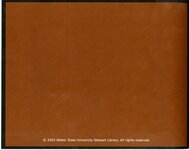| Title |
2003-1 Inside the Hoover Dam Scrapbooks |
| Creator |
Weber State Univesity |
| Contributors |
Utah Construction Company/Utah International |
| Description |
The WSU Stewart Library Annual UC-UI Symposium took place from 2001-2007. The collection consists of memorabilia from the symposium including a yearly keepsake, posters, and presentations through panel discussions or individual lectures. |
| Subject |
Hoover Dam (Ariz. and Nev.); Ogden (Utah); Utah Construction Company |
| Digital Publisher |
Stewart Library, Weber State University, Ogden, Utah, USA |
| Date Original |
2003 |
| Date |
2003 |
| Date Digital |
2008 |
| Temporal Coverage |
2001; 2002; 2003; 2004; 2005; 2006; 2007 |
| Item Size |
8 inch x 10 inch |
| Medium |
booklets |
| Item Description |
13 page booklet with text and black and white photos |
| Type |
Text; Image/StillImage |
| Conversion Specifications |
Archived TIFF images were scanned with an Epson Expression 10000XL scanner. Digital images were reformatted in Photoshop. JPG and PDF files were then created for general use. |
| Master Quality |
400 PPI |
| Language |
eng |
| Relation |
https://archivesspace.weber.edu/repositories/3/resources/212 |
| Rights |
Materials may be used for non-profit and educational purposes; please credit Special Collections Department, Stewart Library, Weber State University. |
| Source |
TC557.5.H6W42 2003 Special Collections, Stewart Library, Weber State University |
| Format |
application/pdf |
| ARK |
ark:/87278/s6a9qa2z |
| Setname |
wsu_ucui_sym |
| ID |
97629 |
| Reference URL |
https://digital.weber.edu/ark:/87278/s6a9qa2z |
| Title |
2003_011_page14and15 |
| Creator |
Stewart Library, Weber State University |
| Image Captions |
From May through September 1931, deadly heat claimed victims, with temperatures ranging between 110-120 and peaking at 140 in the airless portals of the diversion tunnels. Photographer Ben Glaha's "Workman with Water Bag" became an icon of the entire project the determination of muscular workers to bring water to the thirsty Southwest. (Used with permission.13) Little was known about the cause or prevention of heat exhaustion, and only the water boys and the bags they carried offered any relief at the dam site. Some crews worked in dangerous locations where water boys could not go; and some men believed drinking water only increased their discomfort. Eventually doctors encouraged water consumption and an increased salt intake, and the heat-related deaths dwindled. |
| Description |
The WSU Stewart Library Annual UC-UI Symposium took place from 2001-2007. The collection consists of memorabilia from the symposium including a yearly keepsake, posters, and presentations through panel discussions or individual lectures. |
| Subject |
Hoover Dam, Ogden-Utah, Utah Construction Company |
| Digital Publisher |
Stewart Library, Weber State University |
| Date Original |
2003 |
| Date |
2003 |
| Date Digital |
2008 |
| Item Description |
13 page booklet with text and black and white photos |
| Type |
Text; Image/StillImage |
| Conversion Specifications |
Archived TIFF images were scanned at 400 dpi with an Epson Expression 10000XL scanner. Digital images were reformatted in Photoshop. JPG and PDF files were then created for general use. |
| Language |
eng |
| Rights |
Materials may be used for non-profit and educational purposes; please credit Special Collections Department, Stewart Library, Weber State University. |
| Source |
TC557.5.H6W42 2003 Special Collections, Stewart Library, Weber State University |
| Format |
application/pdf |
| Setname |
wsu_ucui_sym |
| ID |
97704 |
| Reference URL |
https://digital.weber.edu/ark:/87278/s6a9qa2z/97704 |


















































